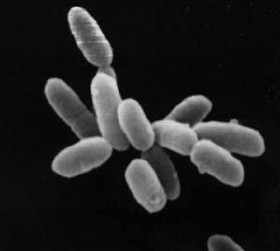Euryarchaeota facts for kids
Quick facts for kids Euryarchaeota |
|
|---|---|
 |
|
| Halobacterium sp. strain NRC-1, each cell about 5 µm in length. | |
| Scientific classification | |
| Domain: | |
| Kingdom: |
Euryarchaeota
Woese, Kandler & Wheelis, 1990
|
| Phyla | |
|
|
| Synonyms | |
|
|
Euryarchaeota (Greek for "broad old quality") is a phylum of archaea. It is one of two phyla of archaea, the other being crenarchaeota. Euryarchaeota are highly diverse and include methanogens, which produce methane and are often found in intestines, halobacteria, which survive extreme concentrations of salt, and some extremely thermophilic aerobes and anaerobes, which generally live at temperatures between 41 and 122 °C. They are separated from the other archaeans based mainly on rRNA sequences and their unique DNA polymerase.
Description
The Euryarchaeota are diverse in appearance and metabolic properties. The phylum contains organisms of a variety of shapes, including both rods and cocci. Euryarchaeota may appear either gram-positive or gram-negative depending on whether pseudomurein is present in the cell wall. Euryarchaeota also demonstrate diverse lifestyles, including methanogens, halophiles, sulfate-reducers, and extreme thermophiles in each. Others live in the ocean, suspended with plankton and bacteria. Although these marine euryarchaeota are difficult to culture and study in a lab, genomic sequencing suggests that they are motile heterotrophs.
Though it was previously thought that euryarchaeota only lived in extreme environments (in terms of temperature, salt content and/or pH), a paper by Korzhenkov et al published in January 2019 showed that euryarchaeota also live in moderate environments, such as low-temperature acidic environments. In some cases, euryarchaeota outnumbered the bacteria present. Euryarchaeota have also been found in other moderate environments such as water springs, marshlands, soil and rhizospheres. Some euryarchaeota are highly adaptable; an order called Halobacteriales are usually found in extremely salty and sulfur-rich environments but can also grow in salt concentrations as low as that of seawater 2.5%. In rhizospheres, the presence of euryarchaeota seems to be dependent on that of mycorrhizal fungi; a higher fungal population was correlated with higher euryarchaeotal frequency and diversity, while absence of mycorrihizal fungi was correlated with absence of euryarchaeota.
Phylogeny
| phylogeny is based on 16S rRNA-based LTP release 121 | Dombrowski et al. 2019, Jordan et al. 2017 and Cavalier-Smith2020. | ||||||||||||||||||||||||||||||||||||||||||||||||||||||||||||||||||||||||||||||||||||||||||||||||||||||||||||||||||||||||||||||||||||||||||||||||||||||||||||||||||||||||||||||||||||||||||||||||||||||||||||
|---|---|---|---|---|---|---|---|---|---|---|---|---|---|---|---|---|---|---|---|---|---|---|---|---|---|---|---|---|---|---|---|---|---|---|---|---|---|---|---|---|---|---|---|---|---|---|---|---|---|---|---|---|---|---|---|---|---|---|---|---|---|---|---|---|---|---|---|---|---|---|---|---|---|---|---|---|---|---|---|---|---|---|---|---|---|---|---|---|---|---|---|---|---|---|---|---|---|---|---|---|---|---|---|---|---|---|---|---|---|---|---|---|---|---|---|---|---|---|---|---|---|---|---|---|---|---|---|---|---|---|---|---|---|---|---|---|---|---|---|---|---|---|---|---|---|---|---|---|---|---|---|---|---|---|---|---|---|---|---|---|---|---|---|---|---|---|---|---|---|---|---|---|---|---|---|---|---|---|---|---|---|---|---|---|---|---|---|---|---|---|---|---|---|---|---|---|---|---|---|---|---|---|---|---|---|
|
The currently accepted taxonomy is based on the List of Prokaryotic names with Standing in Nomenclature (LPSN) and National Center for Biotechnology Information (NCBI) and the phylogeny is based on 16S rRNA-based LTP release 121 by 'The All-Species Living Tree' Project.
|
Other phylogenetic analyzes have suggested that the archaea of the clade DPANN may also belong to Euryarchaeota and that they may even be a polyphyletic group occupying different phylogenetic positions within Euryarchaeota. It is also debated whether the phylum Altiarchaeota should be classified in DPANN or Euryarchaeota. A cladogram summarizing this proposal is graphed below. The groups marked in quotes are lineages assigned to DPANN, but phylogenetically separated from the rest.
|
A third phylogeny by Annotree and GTDB release 05-RS95 (17 July 2020).
|
Euryarchaeota s.s.
|
See also
 In Spanish: Euryarchaeota para niños
In Spanish: Euryarchaeota para niños

